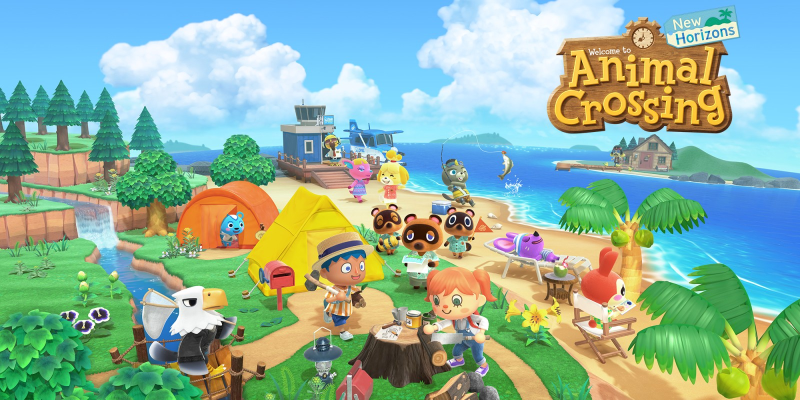Before you shake your head and say, “The last thing this world needs is another Animal Crossing article” — I agree.
The New York Times has called it “the game for the coronavirus moment,” or a whimsical escape from the terrors of global pandemic. Met with extraordinary reception, the game’s release has created a shortage of Nintendo Switches to last potentially until summertime, inspired folks to buy and sell “Animal Crossing” currency on marketplaces like Etsy and Ebay, and even become a staple of the Monterey Bay Aquarium’s aquarium tours, conducted both during sea otter feedings and when docents find new species to add to their virtual collections.
But what is it about this game that has everyone playing it?
You don’t need to be an area expert to know the basic premise of “Animal Crossing.” The player spawns as a pseudo-mayor of a deserted island deeply indebted to a tanuki named Tom Nook. There is one underlying mechanic: by collecting fruit, bugs, natural resources, and fish, the player slowly pieces together the currency to escape debt, if they so choose. Everything else is free-play, with something soothing about the monotony and calmness of the marimba-filled “Animal Crossing” day (that parallels the pre-COVID-19 calendar we lived by). Players will frequently build a routine of play in this real-time game, as days turn to nights, weekdays turn into Stalk Market Sundays, and the setting is backdropped by seasons and the celebrations they bring. Some have made a career around “maximizing” or “optimizing” the gameplay experience, with lofty goals of completing their bug and fishing encyclopedias, earning 5-star ratings on their homes and islands, and ridding their village of ugly villagers. (There’s always one…) With social isolation deeply rooted into the foreseeable future, many have taken to “Animal Crossing: New Horizons” (2020) as their escape from reality: from first-time players to long-time GameCube-era fans who remember a time when the friendly animal villager faces of today were their biggest bullies.
As a more basic player who’s never escaped debt, nor filled a museum, I have always been a sucker for the beautiful aesthetics of the game. Before caving and purchasing the game a month after its initial release, I probably watched several dozen hours of streams and replayed lent copies of “Animal Crossing: Wild World” (2005) and “Animal Crossing: New Leaf” (2012) telling myself that I had seen and played all I needed to. I am too impatient to be a “real” fan, preferring to prioritize capitalism over other, more noble completionist goals, but I am a longtime fan. There is a piece of my childhood deeply embedded in this game, starting from the 2005 release of “Wild World” on the DS through Pocket Camp, which scored my days during my leave of absence last year. Building and maintaining relationships with these characters, while it may seem trivial, has had a tremendous impact on my identity and how I express care and love — and I’ve found a community with similar coming-of-age stories. So after watching a friend create a St. Vincent outfit on a stream last week, latex trench coat and all, I was convinced.
Longtime fans will see a few key non-player characters missing like Resetti and Brewster, whose presence is kept alive with the vague promises of large improvements to be patched in soon (yes, folks have been trying to analyze source code to confirm rumors about updates). It is clear Nintendo implemented some lessons learned from its 2017 release of “Animal Crossing: Pocket Camp,” a free, time-based game that mechanizes and simplifies gameplay into cute, endorphin boosting daily tasks (and a whole suite of attractive paid content). Consistent with this model, not only is “New Horizons” prettier to look at, the mechanics are streamlined by an addictive, “just a few more minutes” carrot-on-a-stick that prioritizes small achievements through compartmentalized milestones. While some might find it reassuring, I find the rewards reinforce how transactional gameplay can be, imposing on and restricting the freedom of playing with no normative goals. The beauty in this game is in the fact that there is no one way to play. It’s kinda boring, kinda mindless, but we love it anyways — no gamified reminders needed. This being said, the depth of customization and design capabilities available for the inner fashion designer, home decorator, urban planner, and waterbender in all of us is tremendous and more than compensates for the goal-oriented hurdles.
Between popular meme pages, streaming services (and streamers), and various outlets of formal and informal published work, the lore of “Animal Crossing” is one all players can participate in, no matter how invested in the fandom they are. While the “true gamers” might shake their heads in disapproval at the mainstream appeal of this game (and gate-keep, as they do), “Animal Crossing” has truly succeeded in taking a pulse of digital connection in the online age. By the end of this week, I will have attended two birthday parties hosted in “Animal Crossing,” seen dozens of memes, and heard it joked about as an alternative classroom space by my professors. Where “New Horizons” shines is in how users choose to interact with the game, and its massive, almost ubiquitous presence in a time of such uncertainty.
Also notable to mention is “good guy” Nintendo whose (serendipitous?) decision in June 2019 to delay the release of the game for the well-being of its developers ended up being a huge win-win.
A special thank you to Cass, Vinh, Luke and Miley for indulging my obsession.
Contact Julie Fukunaga at juliefa ‘at’ stanford.edu.
